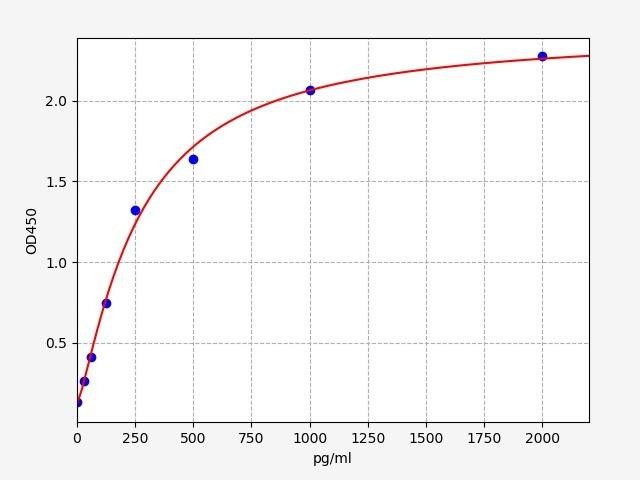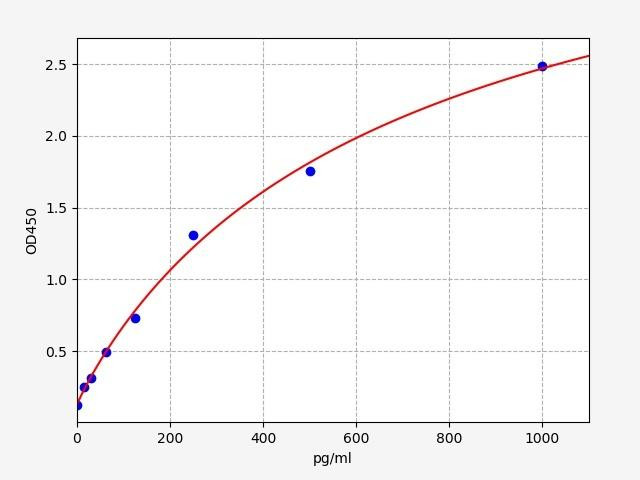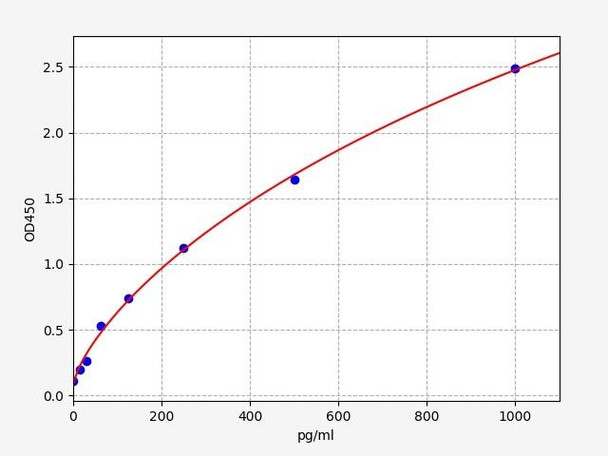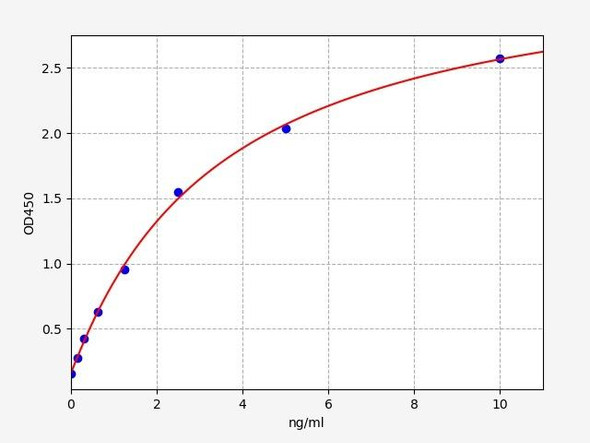Mouse IL-8 ELISA Kit (MOFI01258)
- SKU:
- MOFI01258
- Product Type:
- ELISA Kit
- Size:
- 96 Assays
- Uniprot:
- Q9WVL7
- Sensitivity:
- 9.375pg/ml
- Range:
- 15.625-1000pg/ml
- ELISA Type:
- Sandwich
- Synonyms:
- IL-8, IL8, CXCL8, GCP-1, GCP1, LECT, LUCT, LYNAP, MDNCF, MONAP, NAF, NAP-1, NAP1, 3-10C, AMCF-I, K60
- Reactivity:
- Mouse
- Signaling Molecule:
- Cytokine
Description
Mouse IL-8 ELISA Kit (MOFI01258)
nterleukin-8 (IL-8), also known as CXCL8, is a chemokine involved in immune responses and inflammation regulation in various organisms, including mice. The Assay Genie Mouse IL 8 ELISA kits provide researchers with a reliable and sensitive tool to assess IL-8 concentrations in various biological samples, such as serum, plasma, cell culture supernatants, or tissue lysates. The kits offer a quantitative readout, allowing researchers to accurately determine IL-8 levels and study its role in various disease models, inflammatory conditions, or drug interventions.
Key Features
| Save Time | Pre-coated 96 well plate | |
| Quick Start | Kit includes all necessary reagents | |
| Publication Ready | Reproducible and reliable results |
Overview
|
Product Name: |
Mouse IL-8 ELISA Kit (MOFI01258) |
|
Product Code: |
MOFI01258 |
|
Size: |
96 Assays |
|
Alias: |
IL-8, IL8, CXCL8, GCP-1, GCP1, LECT, LUCT, LYNAP, MDNCF, MONAP, NAF, NAP-1, NAP1, 3-10C, AMCF-I, K60 |
|
Detection Method: |
Sandwich ELISA |
|
Application: |
This immunoassay kit allows for the in vitro quantitative determination of Mouse IL-8 concentrations in serum plasma and other biological fluids. |
|
Sensitivity: |
9.375pg/ml |
|
Range: |
15.625-1000pg/ml |
|
Storage: |
4°C for 6 months |
|
Note: |
For Research Use Only |
Additional Information
|
Recovery |
Matrices listed below were spiked with certain level of Mouse IL-8and the recovery rates were calculated by comparing the measured value to the expected amount of Mouse IL-8 in samples. (Not Available) |
|
Linearity: |
The linearity of the kit was assayed by testing samples spiked with appropriate concentration of Mouse IL-8 and their serial dilutions. The results were demonstrated by the percentage of calculated concentration to the expected. (Not Available) |
|
CV(%) |
Intra Assay <8 Inter Assay <10 |
Kit Components
| Component | Quantity | Storage |
|
ELISA Microplate (Dismountable) |
8x12 strips |
4°C for 6 months |
|
Lyophilized Standard |
2 |
4°C/ -20°C |
|
Sample/Standard Dlution Buffer |
20ml |
4°C |
|
Biotin-labeled Antibody (Concentrated) |
120ul |
4°C (Protection from light) |
|
Antibody Dilution Buffer |
10ml |
4°C |
|
HRP-Streptavidin Conjugate (SABC) |
120ul |
4°C (Protect from light) |
|
SABC Dilution Buffer |
10ml |
4°C |
|
TMB Substrate |
10ml |
4°C (Protection from light) |
|
Stop Solution |
10ml |
4°C |
|
Wash Buffer (25X) |
30ml |
4°C |
|
Plate Sealer |
5 |
- |
Other materials required:
- Microplate reader with 450 nm wavelength filter
- Multichannel Pipette, Pipette, microcentrifuge tubes and disposable pipette tips
- Incubator
- Deionized or distilled water
- Absorbent paper
- Buffer resevoir
Protocol
*Note: Protocols are specific to each batch/lot. For the exact instructions please follow the protocol included in your kit.
Before adding to wells, equilibrate the SABC working solution and TMB substrate for at least 30 min at 37°C. When diluting samples and reagents, they must be mixed completely and evenly. It is recommended to plot a standard curve for each test.
| Step | Procedure |
|
1. |
Set standard, test sample and control (zero) wells on the pre-coated plate respectively, and then, record their positions. It is recommended to measure each standard and sample in duplicate. Wash plate 2 times before adding standard, sample and control (zero) wells! |
|
2. |
Aliquot 0.1ml standard solutions into the standard wells. |
|
3. |
Add 0.1 ml of Sample / Standard dilution buffer into the control (zero) well. |
|
4. |
Add 0.1 ml of properly diluted sample ( Human serum, plasma, tissue homogenates and other biological fluids.) into test sample wells. |
|
5. |
Seal the plate with a cover and incubate at 37 °C for 90 min. |
|
6. |
Remove the cover and discard the plate content, clap the plate on the absorbent filter papers or other absorbent material. Do NOT let the wells completely dry at any time. Wash plate X2. |
|
7. |
Add 0.1 ml of Biotin- detection antibody working solution into the above wells (standard, test sample & zero wells). Add the solution at the bottom of each well without touching the side wall. |
|
8. |
Seal the plate with a cover and incubate at 37°C for 60 min. |
|
9. |
Remove the cover, and wash plate 3 times with Wash buffer. Let wash buffer rest in wells for 1 min between each wash. |
|
10. |
Add 0.1 ml of SABC working solution into each well, cover the plate and incubate at 37°C for 30 min. |
|
11. |
Remove the cover and wash plate 5 times with Wash buffer, and each time let the wash buffer stay in the wells for 1-2 min. |
|
12. |
Add 90 µl of TMB substrate into each well, cover the plate and incubate at 37°C in dark within 10-20 min. (Note: This incubation time is for reference use only, the optimal time should be determined by end user.) And the shades of blue can be seen in the first 3-4 wells (with most concentrated standard solutions), the other wells show no obvious color. |
|
13. |
Add 50 µl of Stop solution into each well and mix thoroughly. The color changes into yellow immediately. |
|
14. |
Read the O.D. absorbance at 450 nm in a microplate reader immediately after adding the stop solution. |
Sample Preparation
When carrying out an ELISA assay it is important to prepare your samples in order to achieve the best possible results. Below we have a list of procedures for the preparation of samples for different sample types.
| Sample Type | Protocol |
|
Serum |
If using serum separator tubes, allow samples to clot for 30 minutes at room temperature. Centrifuge for 10 minutes at 1,000x g. Collect the serum fraction and assay promptly or aliquot and store the samples at -80°C. Avoid multiple freeze-thaw cycles. If serum separator tubes are not being used, allow samples to clot overnight at 2-8°C. Centrifuge for 10 minutes at 1,000x g. Remove serum and assay promptly or aliquot and store the samples at -80°C. Avoid multiple freeze-thaw cycles. |
|
Plasma |
Collect plasma using EDTA or heparin as an anticoagulant. Centrifuge samples at 4°C for 15 mins at 1000 × g within 30 mins of collection. Collect the plasma fraction and assay promptly or aliquot and store the samples at -80°C. Avoid multiple freeze-thaw cycles. Note: Over haemolysed samples are not suitable for use with this kit. |
|
Urine & Cerebrospinal Fluid |
Collect the urine (mid-stream) in a sterile container, centrifuge for 20 mins at 2000-3000 rpm. Remove supernatant and assay immediately. If any precipitation is detected, repeat the centrifugation step. A similar protocol can be used for cerebrospinal fluid. |
|
Cell culture supernatant |
Collect the cell culture media by pipette, followed by centrifugation at 4°C for 20 mins at 1500 rpm. Collect the clear supernatant and assay immediately. |
|
Cell lysates |
Solubilize cells in lysis buffer and allow to sit on ice for 30 minutes. Centrifuge tubes at 14,000 x g for 5 minutes to remove insoluble material. Aliquot the supernatant into a new tube and discard the remaining whole cell extract. Quantify total protein concentration using a total protein assay. Assay immediately or aliquot and store at ≤ -20 °C. |
|
Tissue homogenates |
The preparation of tissue homogenates will vary depending upon tissue type. Rinse tissue with 1X PBS to remove excess blood & homogenize in 20ml of 1X PBS (including protease inhibitors) and store overnight at ≤ -20°C. Two freeze-thaw cycles are required to break the cell membranes. To further disrupt the cell membranes you can sonicate the samples. Centrifuge homogenates for 5 mins at 5000xg. Remove the supernatant and assay immediately or aliquot and store at -20°C or -80°C. |
|
Tissue lysates |
Rinse tissue with PBS, cut into 1-2 mm pieces, and homogenize with a tissue homogenizer in PBS. Add an equal volume of RIPA buffer containing protease inhibitors and lyse tissues at room temperature for 30 minutes with gentle agitation. Centrifuge to remove debris. Quantify total protein concentration using a total protein assay. Assay immediately or aliquot and store at ≤ -20 °C |
|
Breast Milk |
Collect milk samples and centrifuge at 10,000 x g for 60 min at 4°C. Aliquot the supernatant and assay. For long term use, store samples at -80°C. Minimize freeze/thaw cycles. |
Interleukin 8 (IL-8) Background
Interleukin 8 (IL8/CXCL 8)
Interleukin-8 (IL-8), also known as CXCL8, is a chemokine involved in immune responses and inflammation regulation in various organisms, including mice. IL-8 is produced and secreted by various cell types, such as macrophages, neutrophils, and endothelial cells, in response to inflammatory stimuli. Its primary role is to recruit and activate neutrophils to sites of infection or tissue damage. Understanding IL-8 in mice can provide valuable insights into the mechanisms of inflammation and may offer potential therapeutic targets for related diseases.
Interleukin 8 Structure
The mature IL-8 protein structure is characterized by a conserved N-terminal sequence followed by a CXC motif, which gives the chemokine its name. The CXC motif, composed of two cysteine amino acids separated by another amino acid, plays a crucial role in IL-8's function and interaction with its receptors.
Predicted Structure of Human IL 8. Source: Uniprot
Interleukin 8 Function
The primary function of IL-8 in mice is to recruit and activate neutrophils, a type of white blood cell, to sites of infection or tissue damage. IL-8 acts as a chemoattractant by binding to its specific receptors, CXCR1 and CXCR2, which are expressed on the surface of neutrophils. This binding triggers a cascade of intracellular signaling events that promote neutrophil migration toward the site of inflammation. Additionally, IL-8 also stimulates the release of enzymes and reactive oxygen species by neutrophils, further contributing to the immune response.
Interleukin 8 Signalling Pathway
The mechanism of action of IL-8 involves the activation of intracellular signaling pathways upon binding to its receptors. Once IL-8 binds to CXCR1 or CXCR2 on the surface of neutrophils, it triggers the activation of various signaling molecules, including G proteins and protein kinases. These signaling cascades lead to changes in cytoskeletal rearrangement, calcium mobilization, and the release of inflammatory mediators, ultimately facilitating neutrophil recruitment and activation.
Interleukin 8 Clinical Significance
The clinical significance of IL-8 in mice is well-documented, particularly in the context of inflammatory diseases and infections. Elevated levels of IL-8 have been observed in various mouse models of inflammation, such as arthritis, colitis, and lung injury. Moreover, studies have shown that blocking IL-8 or its receptors can attenuate inflammation and reduce tissue damage in these disease models. In infections, IL-8 plays a crucial role in host defense by recruiting neutrophils to the site of infection, where they can eliminate pathogens. However, dysregulated IL-8 production can contribute to excessive inflammation and tissue damage.
IL 8 Inhibitors
IL-8 inhibitors are substances that specifically target and block the activity of interleukin-8 (IL-8), a chemokine involved in inflammation regulation. Monoclonal antibodies directed against IL-8 or its receptors, CXCR1 and CXCR2, have been developed to disrupt IL-8 signaling pathways. These antibodies aim to impede IL-8-mediated neutrophil recruitment and activation, potentially mitigating excessive inflammation and tissue damage. Small molecule inhibitors that target IL-8 receptors have also been investigated as a means to inhibit IL-8 signaling. These molecules interfere with the binding of IL-8 to its receptors, thus disrupting downstream signaling events. In addition, strategies targeting the production or secretion of IL-8 have been explored, including inhibitors of enzymes and signaling pathways involved in IL-8 synthesis or release. The development of effective IL-8 inhibitors may provide novel therapeutic approaches for modulating immune responses and reducing inflammation.
Mouse IL 8 ELISA Kits FAQs
Q: What is the purpose of the Mouse IL-8 ELISA kit?
The Assay Genie Mouse IL-8 ELISA Kits are specifically designed for the quantitative measurement of interleukin-8 (IL-8) levels in mouse samples. IL-8 is an important chemokine involved in inflammation and immune responses. These ELISA kits provide researchers with a reliable and sensitive tool to assess IL-8 concentrations in various biological samples, such as serum, plasma, cell culture supernatants, or tissue lysates. The kits offer a quantitative readout, allowing researchers to accurately determine IL-8 levels and study its role in various disease models, inflammatory conditions, or drug interventions.
Q: What samples can be used with Mouse IL-8 ELISA Kits?
Mouse IL-8 ELISA Kits are designed to measure IL-8 levels in a wide range of mouse samples, including serum, plasma, cell culture supernatants, and tissue lysates. It is important to carefully follow the provided instructions for sample preparation, as different sample types may require specific protocols to ensure accurate and reliable results. Additionally, it is recommended to use freshly collected or properly stored samples to maintain the integrity of IL-8 and obtain reliable measurements.
Q: Are Mouse IL-8 ELISA Kits suitable for other species?
No, Mouse IL-8 ELISA Kits are specifically designed and optimized for the measurement of IL-8 in mouse samples. The antibodies and assay conditions used in these kits are tailored for mouse IL-8 detection. For the measurement of IL-8 in samples from other species, including humans or other animals, species-specific ELISA kits should be used to ensure accurate and reliable results.
Q: Where can I find additional technical support or assistance with the Mouse IL-8 ELISA kit?
For any technical inquiries or assistance regarding the Mouse IL-8 ELISA kit, you can reach out to our team. They will be available to answer your questions and provide the necessary guidance to ensure a successful experiment.
Related Products

| Mouse TNF alpha ELISA Kit | |
|---|---|
| ELISA TYPE: | Sandwich ELISA, Double Antibody |
| SENSITIVITY: | 18.75pg/ml |
| RANGE: | 31.25-2000pg/ml |

| Mouse IL-6 ELISA Kit | |
|---|---|
| ELISA TYPE: | Sandwich ELISA, Double Antibody |
| SENSITIVITY: | 9.375pg/ml |
| RANGE: | 15.625-1000pg/ml] |

| Mouse IL-10 ELISA Kit | |
|---|---|
| ELISA TYPE: | Sandwich ELISA, Double Antibody |
| SENSITIVITY: | 9.375pg/ml |
| RANGE: | 15.625-1000pg/ml |






